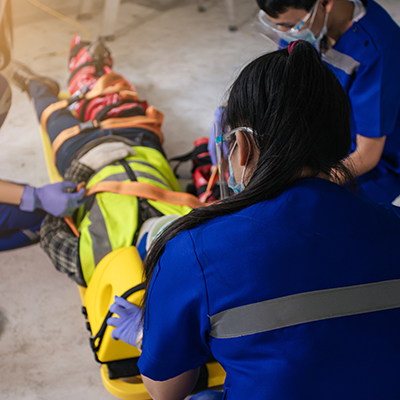Trauma patients that present with potential spinal injuries deliver a unique set of challenges for emergency medical technicians (EMTs) and first responders when applying prehospital care. The most important factor, though, is keeping the victim immobilized and in a stable position throughout the entire patient transport process.
While it often takes multiple people (EMTs, firefighters etc.) to keep a single patient immobilized and secure, there are multiple options (stretcher vs. backboard, etc.) for transporting a patient to the hospital by ambulance.
The Need for Spinal Immobilization
Following a spine injury, the fractured vertebrae can become unstable and shift in a non-anatomical fashion, potentially causing spinal cord injury (with sharp edges of broken vertebrae or bone fragments damaging the spinal cord). This potential for injury is the reason why paramedics and emergency medical services (EMS) are so concerned about the stabilization of a patient’s spine when they arrive on scene.
After a patient is taken to safety, or removed from their vehicle using an extrication device, they are placed on some sort of spinal immobilization device that acts like a full body splint. During extrication and patient transfer, spinal immobilization is also paramount for rescuers.
Backboards: Losing Influence?
Rigid longboard spinal immobilization devices, otherwise known as backboards or long spine boards, have been a tool in the arsenal of EMS providers for decades. Emergency medicine’s popular opinion was that regardless of injury, a severely injured patient should be treated as if he or she has a spinal injury, and that the patient should be immobilized until they are transported from a first aid situation to hospital care.
“Spinal Motion Restriction,” or SMR, has now come into use alongside immobilization to describe the minimization of unwanted spinal movement. The latest research indicates that spinal immobilization is most effectively utilized in cases of drug or alcohol intoxication, neurologic issues (numbness or tingling), or a distracting injury that makes neck and spinal examination impossible or unreliable.
Scoop Stretcher Usage
Scoop stretchers are one of the latest innovations in immobilization for spine-injured patients. A scoop stretcher, like the Ferno Scoop Stretcher, or the Hartwell Medical Combicarrier II Backboard, is designed to separate into two halves which are placed on either side of the patient. The scoop stretcher closes with a scissor-like motion, gently scooping up the patient without the need for the “log roll maneuver” used to place a patient onto a rigid backboard. Most scoop stretchers are adjustable for different body sizes and heights.
In some cases, a head immobilizer may be employed in conjunction with a rigid cervical collar to minimize head movement. While the cervical collar prevents up and down movement, the head immobilizer prevents side to side movement. Head immobilizers use plastic-coated foam blocks along with padded straps to comfortably stop the patient’s head from moving from side to side. This keeps the vertebrae of the cervical spine from shifting and potentially causing harm to the patient.
Vacuum Mattresses
Another form of patient transport is a vacuum mattress, which is an inflatable mattress that cushions a patient and allows them to be transported in multiple positions, including supine, knees flexed, or an elevated torso position. This is especially helpful for elderly patients who may be uncomfortable lying flat on their backs, or patients with severe injuries to their back or pelvis.
A vacuum mattress helps to reduce the possibility of further injury to the patient during transport. In scenarios where a patient must be transported over a long distance, a vacuum mattress is preferable to a long backboard for spinal immobilization. Most vacuum mattresses are also X-ray and MRI compatible so the patient does not have to undergo unnecessary movement.
Patient Immobilization: More Options Than Ever
With the increased research on spinal immobilization, it’s up to the emergency medical staff at the scene to make the best determination at the time with the information that’s available to them. First responders have more tools available than ever before to be able to accommodate victims on a case-by-case basis, as long as they are acting within the constraints of local health protocols.
For the latest technology in patient immobilization (and other medical supplies and equipment) visit Penn Care. You will find backboards, scoop stretchers, head immobilizers, and other accessories to keep victims safe and well cared for.



